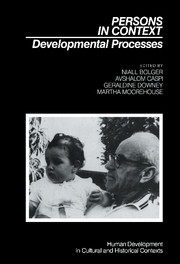Book contents
- Frontmatter
- Contents
- Preface
- Contributors
- 1 Development in context: research perspectives
- 2 Interacting systems in human development Research
- 3 Children, families, and communities: ways of viewing their relationships to each other
- 4 Human development and social change: an emerging perspective on the life course
- 5 Family process: loops, levels, and linkages
- 6 On the constructive role of problem behavior in adolescence
- 7 The sociogenesis of self concepts
- 8 Putting persons back into the context
- 9 How genotypes and environments combine: development and individual differences
- Author index
- Subject index
3 - Children, families, and communities: ways of viewing their relationships to each other
Published online by Cambridge University Press: 04 May 2010
- Frontmatter
- Contents
- Preface
- Contributors
- 1 Development in context: research perspectives
- 2 Interacting systems in human development Research
- 3 Children, families, and communities: ways of viewing their relationships to each other
- 4 Human development and social change: an emerging perspective on the life course
- 5 Family process: loops, levels, and linkages
- 6 On the constructive role of problem behavior in adolescence
- 7 The sociogenesis of self concepts
- 8 Putting persons back into the context
- 9 How genotypes and environments combine: development and individual differences
- Author index
- Subject index
Summary
It is standard practice in the social sciences to say that people are influenced by their environments as well as by internal forces and that the influence occurs in a two-way fashion. It is no easy task, however, to specify how effects occur or how particular environmental features are linked to particular qualities of people or particular developmental outcomes. The task is difficult enough when we limit descriptions of environmental contacts to face-to-face interactions. It becomes even more difficult when we begin to heed Bronfenbrenner's (1979) call to pay attention to such settings as school, workplace, or neighborhood and at the same time to treat these in a more dynamic fashion than by referring to the usual “social address labels” of socioeconomic status, ethnicity, or culture.
How should we proceed if we wish to take account of children, other family members, and people or conditions outside the family? I shall do so by singling out several themes in discussions of family-community relationships, all related to identifying the processes that may be involved.
The first two sections deal with some orientations that get in the way of cleareyed accounts: the treatment of families or settings as units, and the presence of value judgments. As these orientations are rethought, new possibilities emerge for the descriptions of settings, development, and process.
In the remaining sections I focus on particular processes that might underlie relationships among children, parents, and communities.
- Type
- Chapter
- Information
- Persons in ContextDevelopmental Processes, pp. 50 - 76Publisher: Cambridge University PressPrint publication year: 1989

